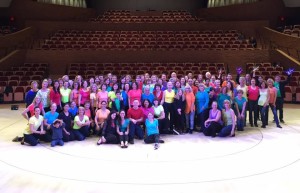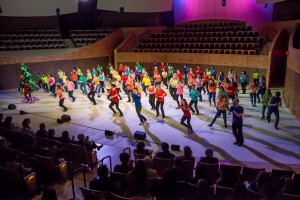An intriguing email popped up on my laptop last January from Stanford Live regarding a casting call for community “civilian” performers for Bolero Silicon Valley. To celebrate Stanford’s 125th anniversary, Stanford Live had commissioned NY-based Keigwin+Company to create a group dance performance to Bolero, the epic orchestral piece by Maurice Ravel. Succumbing to curiosity, I attended the casting call. Two weeks later, I was thrilled to be accepted as a cast member. On April 2, Bolero Silicon Valley premiered to delighted audiences at Bing Concert Hall, complete with dancers, colorful drones, and even the Stanford Tree.
I had spent my entire career in Silicon Valley tech companies leading many complex projects requiring analytical thinking and cross-functional teamwork. With only rudimentary movement skills based on occasional Zumba classes, I fully expected to learn more about dance with Bolero. What I didn’t expect, however, was to glean lessons about collaborative leadership by working with choreographer Larry Keigwin and his talented team, Ashley Browne and Emily Schoen.
When we first met at rehearsals, the 60+ members of the cast and crew were strangers. We were a diverse group in age, demographics, professions, and accents. Few had any previous dance or stage experience. The leadership required to direct this diverse cast, to create something wonderful from a blank stage canvas to a complex and coordinated 15-minute dance theater in 13 days was simply phenomenal.
Here are key takeaways on collaborative leadership from my Bolero cast experience:
- Build collaboration into the process. For Bolero Silicon Valley, collaboration was woven in from audition to rehearsals to final show. Once identified, cast members were asked for input about life in Silicon Valley and ideas for translating this into the performance. Diverse mechanisms were used to solicit and collect the feedback, from individual thoughts online, input to the staff, and onstage during rehearsals. This optimizes for a diverse group since some people preferred the anonymous input method while others felt comfortable giving feedback openly and publicly. Inclusiveness leads to collaborative leadership.
- Receiving input is not enough. Especially as the creative leader, be truly open to input and respond to new ideas. If the choreographer had a grand template for the dance, he did not reveal it in advance to discourage new ideas. Thoughtfully, he first got the architecture (“the map”) right, then “sprinkled in” the artistic pieces, and finally optimized (“cleaned up”). When someone had an idea that he didn’t understand, instead of dismissing it Larry would pause and say, “Show me.” Participants felt heard, even if their original idea did not make the final cut.
- Find hidden talent in the group by asking explicitly for it. A few times, Larry asked openly whether we had jugglers, ping-pong players, and yoga teachers in the group. This is a simple lesson that can be applied in real life organizational settings to surface talent or expertise in the group beyond the expectations of any individual’s role-based skills. Too often, we make assumptions about people’s skills and abilities based on an incomplete understanding of them, and thus miss out on incorporating more talent and skills into the project.
- An effective leader must have the humility to admit when things are not going well and change for the greater good. Successful people are often wedded to their proven ideas, and artistic geniuses are often associated with large egos. A great leader, however, recognizes both the potential strengths and limitations of the team, and adjusts for the best outcomes. During rehearsal, several dance sequences proved too complicated to perform smoothly as a group. Faced with this, our leader said, “Now we know what we [choreographers] need to do.” Instead of blaming the cast for our inability to execute the moves, the leader chose to take the responsibility and simplified the choreography.
- Motivate and challenge the team, regardless of individual abilities, to do their best. During the early rehearsals when our movements were disjointed and awkward, Larry asked us to “trust ourselves” because he trusted us to develop to our heightened potential. Such encouragement motivated the cast to be unafraid to try something new and to lose our self-consciousness. After the basic dance was nearly developed, he then challenged us to “make the ordinary extraordinary”. What a great way to get the cast to stretch to our ultimate creativity and expressiveness!
These are just some of the simple but powerful collaborative leadership lessons I took away. In Silicon Valley, where the emphasis is on STEM disciplines and left-brain activities, it was a breath of fresh air to exercise more of our right-brain hemisphere through the building of an artistic work with the community. The unexpected bonus was the substantive collaborative leadership lessons I can apply to my work in the business world. Thank you to my fellow cast members, Stanford Live and to Keigwin+Company for this outstanding growth experience.
– Denise Peck, MBA 1985

